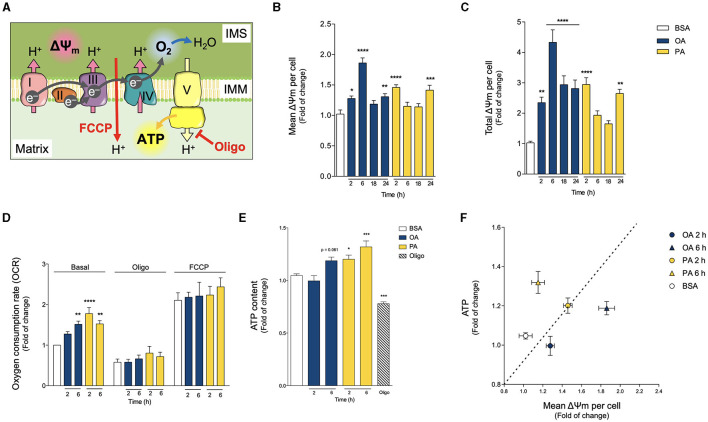Figure 4.
Oleic and palmitic acids differentially modulate mitochondrial bioenergetics in HepG2 cells. (A) Schematics of mitochondrial respiration through the mitochondrial matrix and the intermembrane space (IMS). Complexes I, III and IV pump H+ across the inner mitochondrial membrane (IMM), generating the mitochondrial transmembrane potential (ΔΨm), and ultimately, transforming O2 into H2O. Then, complex V synthesizes ATP using the proton gradient of the ΔΨm. Oligomycin (Oligo) inhibits Complex V, thus leading to the build-up of the ΔΨm, which hampers mitochondrial respiration. FCCP, on the other hand, dissipates the ΔΨm, thereby eliminating the electrochemical restraint on mitochondrial respiration. (B,C) Mean and whole-cell Δψm of HepG2 cells treated with 200 μM of oleic acid (OA) or palmitic acid (PA) for 0–24 h, measured using MitoTracker Orange and confocal fluorescence microscopy. Data are from N = 6–20 cells analyzed from three independent experiments. (D) Oxygen consumption rate (OCR) of cells treated as in A, measured after 2 and 6 h of treatment. Baseline respiration, non-ATP-associated respiration (Oligo 400 μM), and the maximal respiratory capacity (FCCP 20 μM) were measured sequentially for 3 min (N = 5). (E) Intracellular ATP levels of cells treated as in A, quantified after 2 and 6 h of treatment. Oligo 5 μg/mL for 3 h was used as a positive experimental control (N = 5). (F) Mitochondrial efficiency expressed as ATP levels vs. OCR at 2 h of OA or PA treatments. Results are shown as mean ± SEM; *p < 0.05; **p < 0.01; ***p < 0.001; and ****p < 0.0001 vs. BSA.

